Powers & Paragons: Superheroic Role Playing with OD&D - Part One
(This may form an eventual PDF (much like my Star Wars rules did), or it may actually morph into a complete game that I will release through Elf Lair Games. I'm not sure. For now it's a few thoughts I had.)
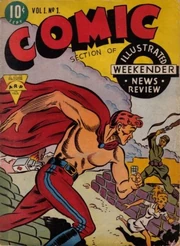
If there's one genre out there that is as popular with the sci-fi/fantasy community as high fantasy, it's superheroes. Since they first debuted in the pulp magazines in the 20s and 30s with characters like The Shadow, Doc Savage, The Bat and the like, super-powered masked vigilantes have held the fascination of the world. Eventually they made their way into comic books, where these powered men and women have formed a new take on mythology, the modern gods and goddesses of our popular culture. It occurred to me, in thinking about it, that OD&D, being a stunningly flexible system, can easily handle superhero games, so I wanted to put some notes down regarding how it works.
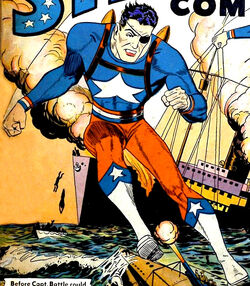
The first thing we need to do, to figure out how supers work in our game, is to consider the different approaches to power. To this end, I'm opening up the door to all four supplements to OD&D, as these allow for many different kinds of heroes. For the most part, any hero that has powers already, from Magic Users to Clerics to sub-classes like the Monk, Druid and Paladin, can work just fine in a supers game as they sit, needing only to be reconsidered for modern era games. Magic Users, for example, represent the masters of the mystic arts, while Clerics make outstanding demon and vampire hunters. In a modern supers game it's recommended that clerical characters not be restricted to bludgeoning weapons; they can use swords and even guns in their quest to tackle supernatural horrors.
Psionics, as presented in Supplement 3, are a clear addition for supers games, but should work as Force powers do in Star wars, rather than as I discuss in my series in Psionics in D&D, though the latter is also a possibility. For purposes of a supers game, ignore the Dark Side corruption mechanic introduced in the Star Wars rules; all psionic attacks and defenses are available to all psionic characters. In addition, if a character wishes to play a psionic hero, they needn't check for psychic potential; they are assumed to have it. All other rules remain in play.
While all supplements are in play in terms of available character classes, the use of the original Men & Magic rules regarding d6 hit dice for all classes and d6 damage for all weapons and attacks are recommended for these rules.
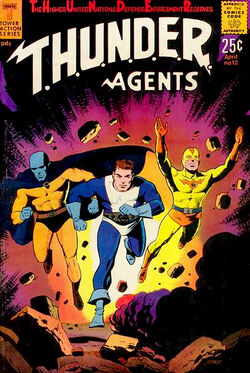
Characters who wish to play a superhero with standard superpowers should portray a fighting man or thief as their core class. They will then build a "power suite" that forms the core of their superheroic abilities. Superhero powers generally fall into one of several categories, and the player should choose a category to start from the following choices:
1. Blaster
2. Physical Augment
3. Mover
4. Elemental Control
5. Ghost
6. Gadget-Man
7. Transmuter
8. Defender
Note that psionics, magic, and martial arts are not listed above, as they are represented by various other character classes. Let's look at each in turn:

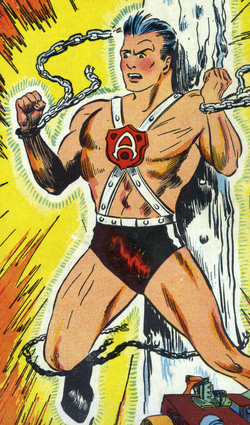
As part of your overall origin story, however, you need to develop a background for your character. Who are they, where do they come from, and where did they get their powers? Are they an alien whose biological makeup is enhanced by the Earth's...magnetic field? Are they an experiment gone awry? Were they born with a rare deviant recessive gene that erupted at a moment of stress, granting them extraordinary abilities? Were their powers the result of an accident?
Another part of the origin story is your character's weakness. Every superhero has a weakness, something that acts as their specific bane. It could be that you can't fully control your powers, making you a potential danger to those around you or suffering the potential to lose them at a critical moment. It could be that a certain substance is a dangerous anathema to you. It could be that you can't defend against powers of a specific other nature, like psionics or magic. Choose a weakness for your character. This weakness has to be something that represents a genuine threat and can show up in game for the DM to use against you at critical moments.
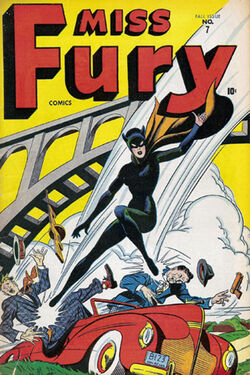
When you choose your primary power theme, you get the basic power for that theme. Thereafter, at every odd level you achieve, you gain one additional power or improvement. Starting at level 5, you may choose a second power suite instead of improving your existing one, gaining the primary power of that theme, as though you were a first level character. From there on you can select powers from either theme, but your secondary power suite will always be treated as four levels lower than your primary. At level 9, you can opt to choose a third power suite, again treated as first level, with any powers you select from that third suite always being eight levels below your primary.
As with anything in the game, the DM has final say over whether you can choose multiple power themes or whether the powers you choose are compatible.
That's the basics of character creation. Next up we'll look at some of the potential specific powers under each power suite or theme.

Introduction
If there's one genre out there that is as popular with the sci-fi/fantasy community as high fantasy, it's superheroes. Since they first debuted in the pulp magazines in the 20s and 30s with characters like The Shadow, Doc Savage, The Bat and the like, super-powered masked vigilantes have held the fascination of the world. Eventually they made their way into comic books, where these powered men and women have formed a new take on mythology, the modern gods and goddesses of our popular culture. It occurred to me, in thinking about it, that OD&D, being a stunningly flexible system, can easily handle superhero games, so I wanted to put some notes down regarding how it works.

Approaches to Power and Core Rules
The first thing we need to do, to figure out how supers work in our game, is to consider the different approaches to power. To this end, I'm opening up the door to all four supplements to OD&D, as these allow for many different kinds of heroes. For the most part, any hero that has powers already, from Magic Users to Clerics to sub-classes like the Monk, Druid and Paladin, can work just fine in a supers game as they sit, needing only to be reconsidered for modern era games. Magic Users, for example, represent the masters of the mystic arts, while Clerics make outstanding demon and vampire hunters. In a modern supers game it's recommended that clerical characters not be restricted to bludgeoning weapons; they can use swords and even guns in their quest to tackle supernatural horrors.
Psionics, as presented in Supplement 3, are a clear addition for supers games, but should work as Force powers do in Star wars, rather than as I discuss in my series in Psionics in D&D, though the latter is also a possibility. For purposes of a supers game, ignore the Dark Side corruption mechanic introduced in the Star Wars rules; all psionic attacks and defenses are available to all psionic characters. In addition, if a character wishes to play a psionic hero, they needn't check for psychic potential; they are assumed to have it. All other rules remain in play.
While all supplements are in play in terms of available character classes, the use of the original Men & Magic rules regarding d6 hit dice for all classes and d6 damage for all weapons and attacks are recommended for these rules.

Power Suites and Theme
Characters who wish to play a superhero with standard superpowers should portray a fighting man or thief as their core class. They will then build a "power suite" that forms the core of their superheroic abilities. Superhero powers generally fall into one of several categories, and the player should choose a category to start from the following choices:
1. Blaster
2. Physical Augment
3. Mover
4. Elemental Control
5. Ghost
6. Gadget-Man
7. Transmuter
8. Defender
Note that psionics, magic, and martial arts are not listed above, as they are represented by various other character classes. Let's look at each in turn:

The Blaster
The blaster, quite simply, is a hero whose primary power is to emit some sort of ranged attack. It could be simple blasts of force. It can be kinetic energy used to charge objects which are then thrown. It could be spikes or bone shards that erupt from their body. It could be fire, lightning, or any other sort of energy. It could just be that your character carries an arsenal of guns that they use to take down criminals. As the hero learns how to use their powers, their blasts can take different forms. They go from a simple bolt of energy to area effect attacks, shaped charges, and even melee attacks.The Physical Augment
Physical augments can take many forms. The key factor here is that one or more of their physical attributes are augmented beyond the human norm. These characters have super strength, super agility, super endurance, or the like. They tend to be melee powerhouses, whether because they can land multiple attacks, they can deliver a whollop with a single blow, or they can take damage like nobody's business.The Mover
The mover has some sort of movement power as their primary ability. They could be a speedster, able to move faster than the speed of sound. They might be able to fly. They could swim like a fish. They might be able to move through the trees like a monkey in the jungle. They might even have the ability to swing through the city buildings on strands of super-strong thread that they generate either biologically or through a device. They might even have line of sight teleportation. The key factor is, the Mover has some sort of special movement ability.The Elemental Controller
Earth, Air, Fire, Water...elemental controllers have mastery over one of these four elements. They can perform astounding feats within their own element, and even may mix elements of other heroes within their powers--a fire controller, for example, may be able to generate blasts of flame as blasters, or Earth creatures might be able to turn themselves into stone, mixing elements of the Augment and Transmuter. Very often, they are immune to the element they control, but the opposite element is anathema to them: air creatures, for example, may be intensely claustrophobic, while fire controllers lose their powers or even actually take damage from being submerged in water.The Ghost
The ghost has powers of stealth and invisibility. They can move without making a sound and without leaving a trace. They can vanish from plain sight. They are masters of shadow and the art of being unseen.The Gadget Man
The Gadget Man has no specific powers aside from being super smart or having a friend who is super smart. Rather, their abilities come from super sicence. They have gadgets that can perform impossible feats, and can mimic many of the abilities above, but they are limited by the arsenal at their disposal on any given mission.The Transmuter
The transmuter is a hero whose powers revolve around turning one thing into another. They might be able to shapeshift, assuming different forms such as animals to gain their inherent abilities. They could have a single alternate form--they turn into an ancient deity, an archangel, or a gigantic rage-monster under the right conditions. They might be able to control reality itself, summoning objects from nothing by manipulating the quantum realm or the power of the human will. Some transmuters absorb the powers and abilities from others, and gain access to them on a temporary basis. They key is that these characters have a primary power that results from transformation.The Defender
Defenders have a primary power that protects themselves and/or others. It could be a mystical suit of armor that they summon when going into battle. It could be that they have the ability to nullify other powers. Perhaps they can generate a dome of force or a directed shield that can be used to protect themselves, another person, or even a group. Some Defenders have a mystical ability to redirect damage, eiher to or from others, so that when they take a hit, someone else suffers damage, or when someone else takes a hit, they suffer the damage. Their primary ability, however, is always purely defensive in nature.
Paragon Heroes
Paragon heroes are those superheroes who have cosmic-level powers: they can fly, see through solid objects, fire heat rays from their eyes, have off-the-chart super strength, and are completely invulnerable to everything except magic or a chunk of rock from their homeworld. Generally speaking, these characters are neither fun to play for more than a session or two, nor fun to run as a DM. They also require taking multiple power sets to accomplish. While it's possible to create such heroes in this manner, the DM should decide whether they want that level of power in their game. In general, creating paragon-level heroes simply requires the DM allowing players to choose multiple power sets to build their hero.The Origin Story
It's inevitable that players complain about superhero games not allowing them to make paragon-level polymaths out of the gate, but if one thinks about it, almost every superhero in comics or the pulps begins with an origin story, as they discover their powers and grow into them. Your first through third level (or even higher) characters represent going through that origin story. Each character comes into their powers and learns to both master them and work as a team. Remember that RPGs are something of a different paradigm than comics, and part of the point is to grow and develop your characters.As part of your overall origin story, however, you need to develop a background for your character. Who are they, where do they come from, and where did they get their powers? Are they an alien whose biological makeup is enhanced by the Earth's...magnetic field? Are they an experiment gone awry? Were they born with a rare deviant recessive gene that erupted at a moment of stress, granting them extraordinary abilities? Were their powers the result of an accident?
Another part of the origin story is your character's weakness. Every superhero has a weakness, something that acts as their specific bane. It could be that you can't fully control your powers, making you a potential danger to those around you or suffering the potential to lose them at a critical moment. It could be that a certain substance is a dangerous anathema to you. It could be that you can't defend against powers of a specific other nature, like psionics or magic. Choose a weakness for your character. This weakness has to be something that represents a genuine threat and can show up in game for the DM to use against you at critical moments.

Choosing Powers
The first step in creating a powered hero is choosing your primary theme. This will determine the main powers you have available. Some will be of the "single power that gets better" variety--a blast, for example, is a blast, however you shake it, though you may gain new ways to use the blast. Others will contain multiple options you can choose as you increase in levels and master your abilities. Elemental controllers, for example, could gain the ability to manipulate existing elements, might gain the ability to create bursts, and eventually might be able to transform into a full elemental creature.When you choose your primary power theme, you get the basic power for that theme. Thereafter, at every odd level you achieve, you gain one additional power or improvement. Starting at level 5, you may choose a second power suite instead of improving your existing one, gaining the primary power of that theme, as though you were a first level character. From there on you can select powers from either theme, but your secondary power suite will always be treated as four levels lower than your primary. At level 9, you can opt to choose a third power suite, again treated as first level, with any powers you select from that third suite always being eight levels below your primary.
As with anything in the game, the DM has final say over whether you can choose multiple power themes or whether the powers you choose are compatible.
That's the basics of character creation. Next up we'll look at some of the potential specific powers under each power suite or theme.




I think you’re conflating special effects with archetypes with Powers.
ReplyDeleteMay I suggest two sets of choices at generation?
One is archetype.
1. Tank
2. Blaster
3. Support and healing
Each could have a secondary power from the other sets.
The second choice is motivation.
1. Upholding the good (Superman)
2. Responsibility of power (spider-man)
3. Thrill seeking or adventuring (booster gold, speedball, Fantastic four minus the thing)
4. Seeking justice (Batman)
5. Unwanted power/misfit (x-men, doom patrol)
That gives you clear classes and an alignment of sorts.
As far as how the character has powers, you can then say “cosmic rays” or “super suit” or “magic” or “born that way” or whatever else seems to work for you and the player.
These are special effects which should have some minimal impact on the game but are secondary to the archetype.
Has this ever become a PDF file? I like the way you're going with this.
ReplyDeleteAlas, no. I got distracted with some other things. Someday I hope to get back to it, and then it will likely become a PDF (If not a game for Elf Lair using the O.G.R.E.S. system).
Delete